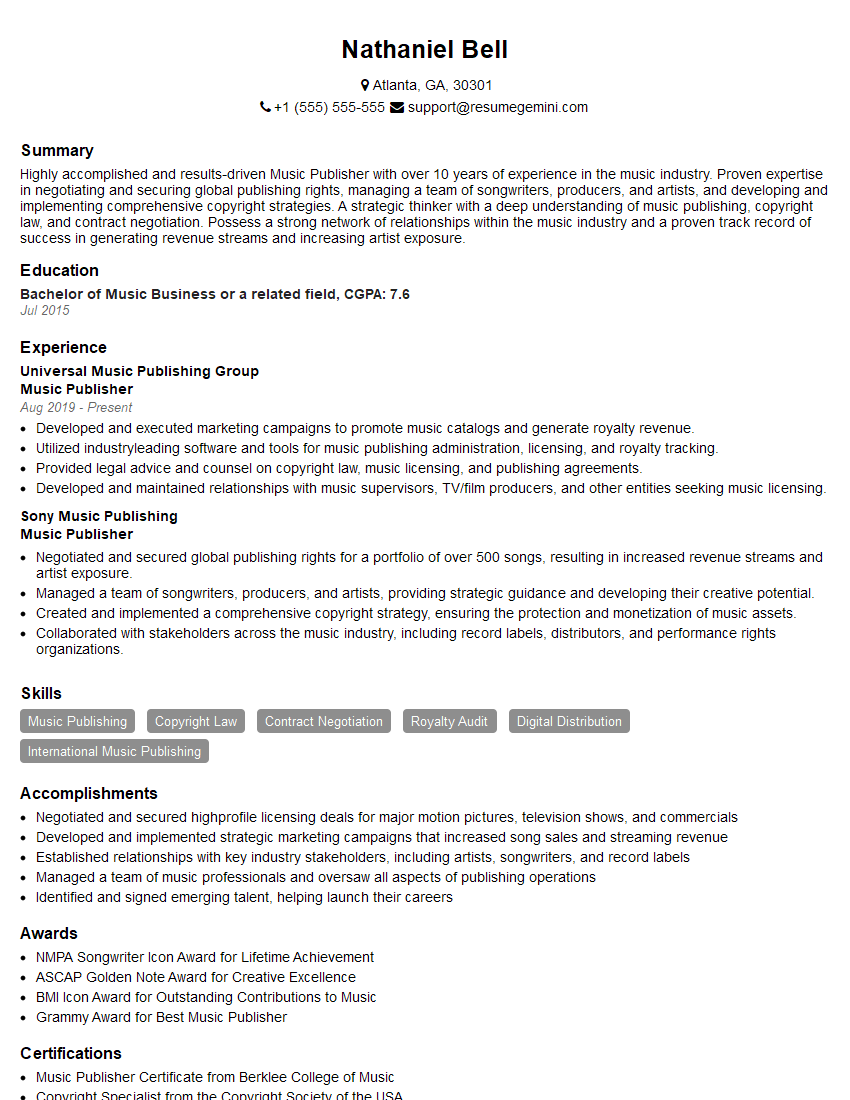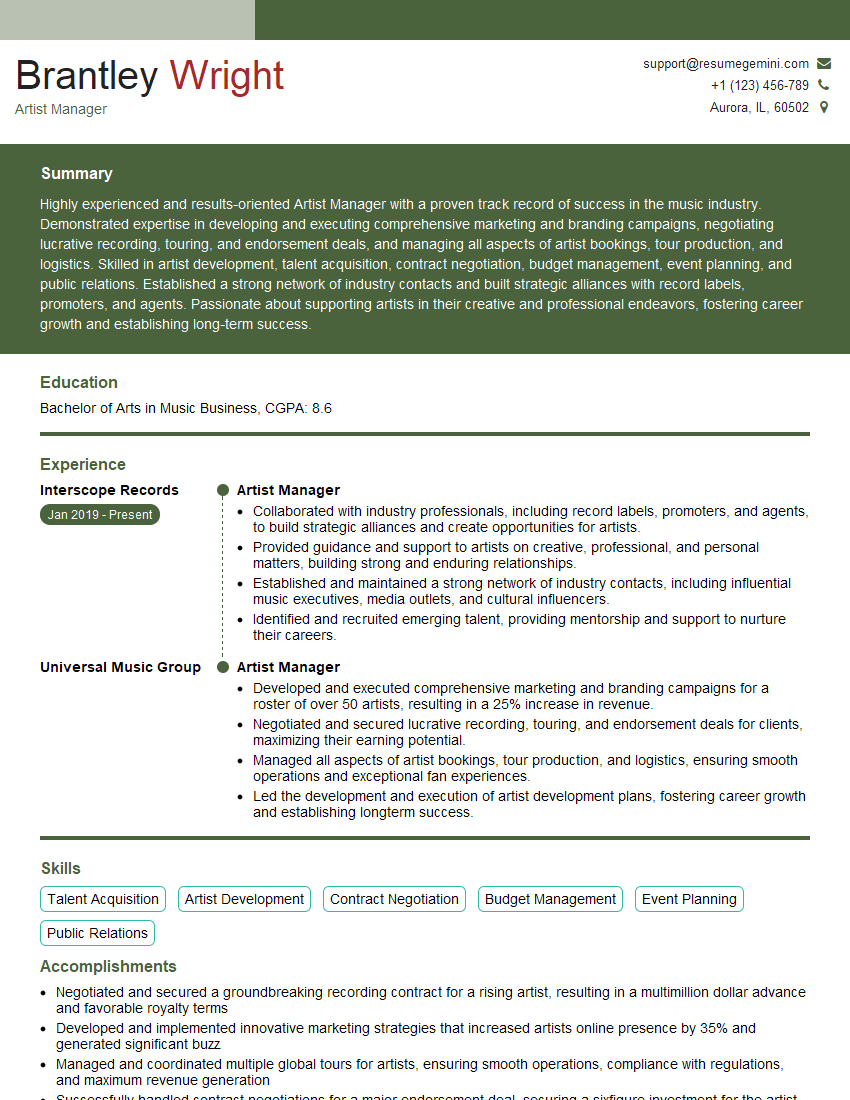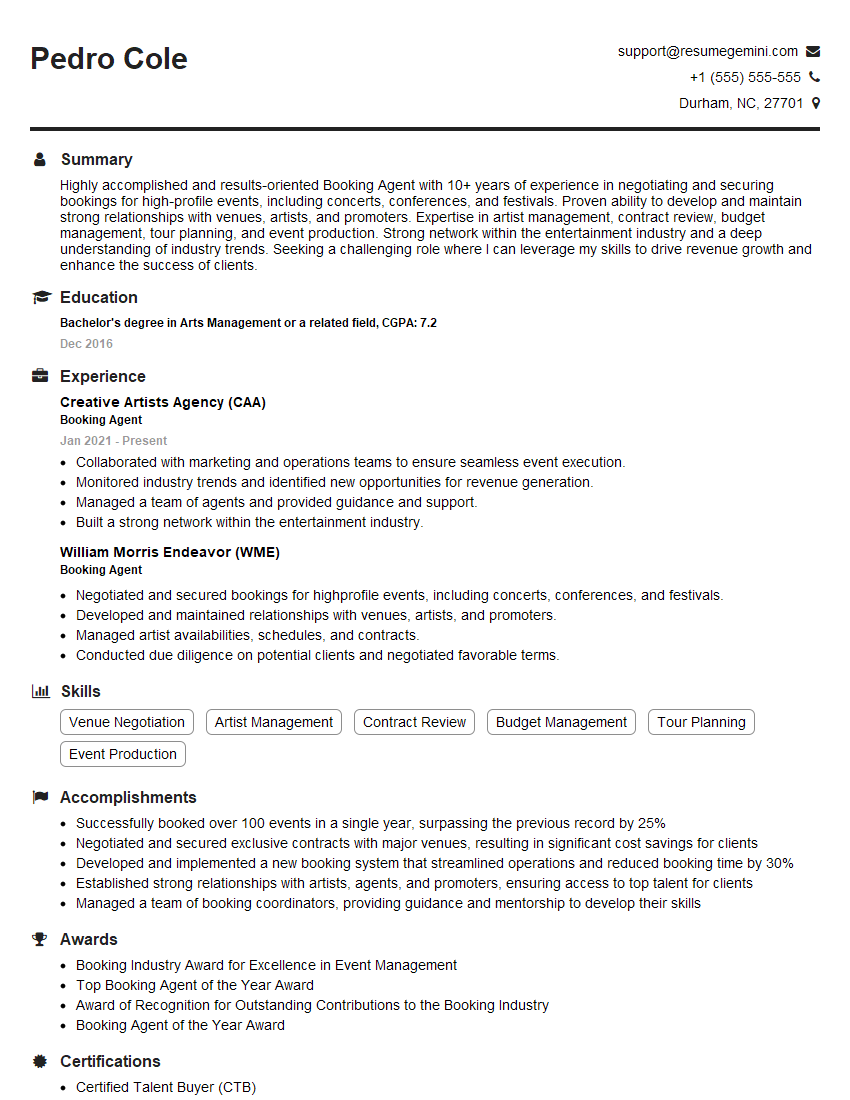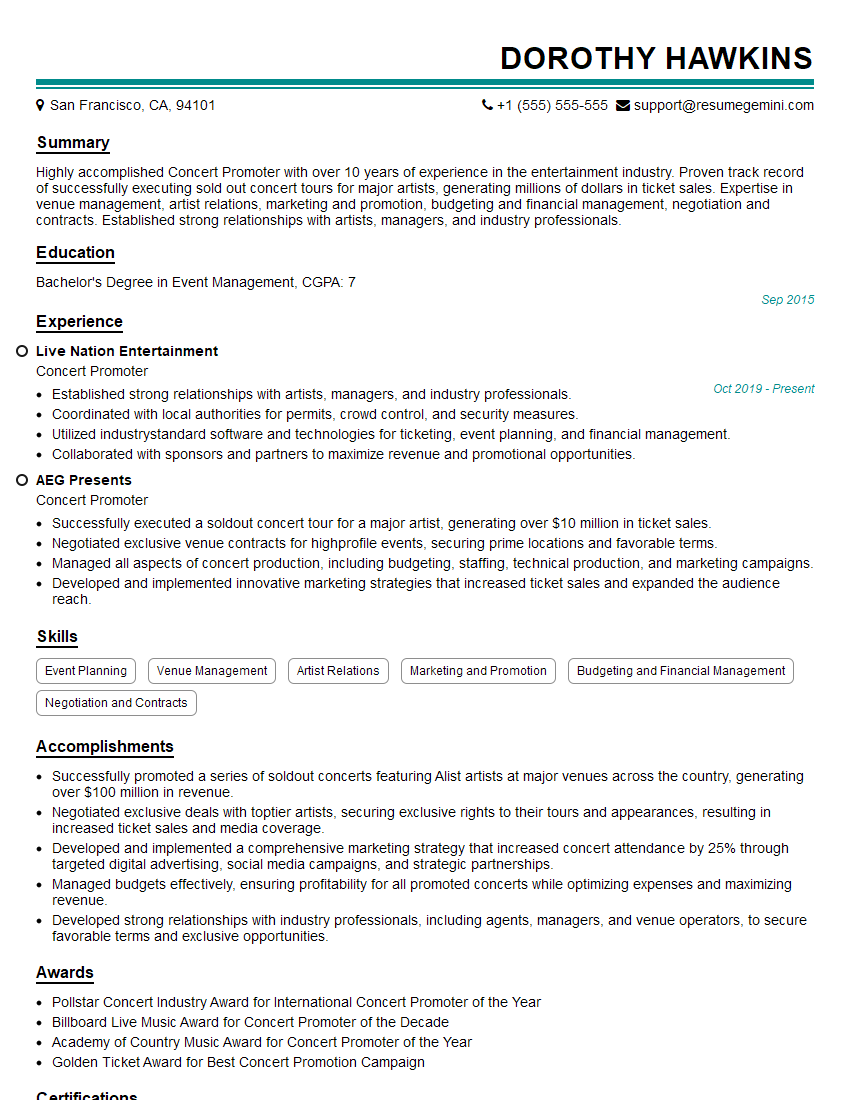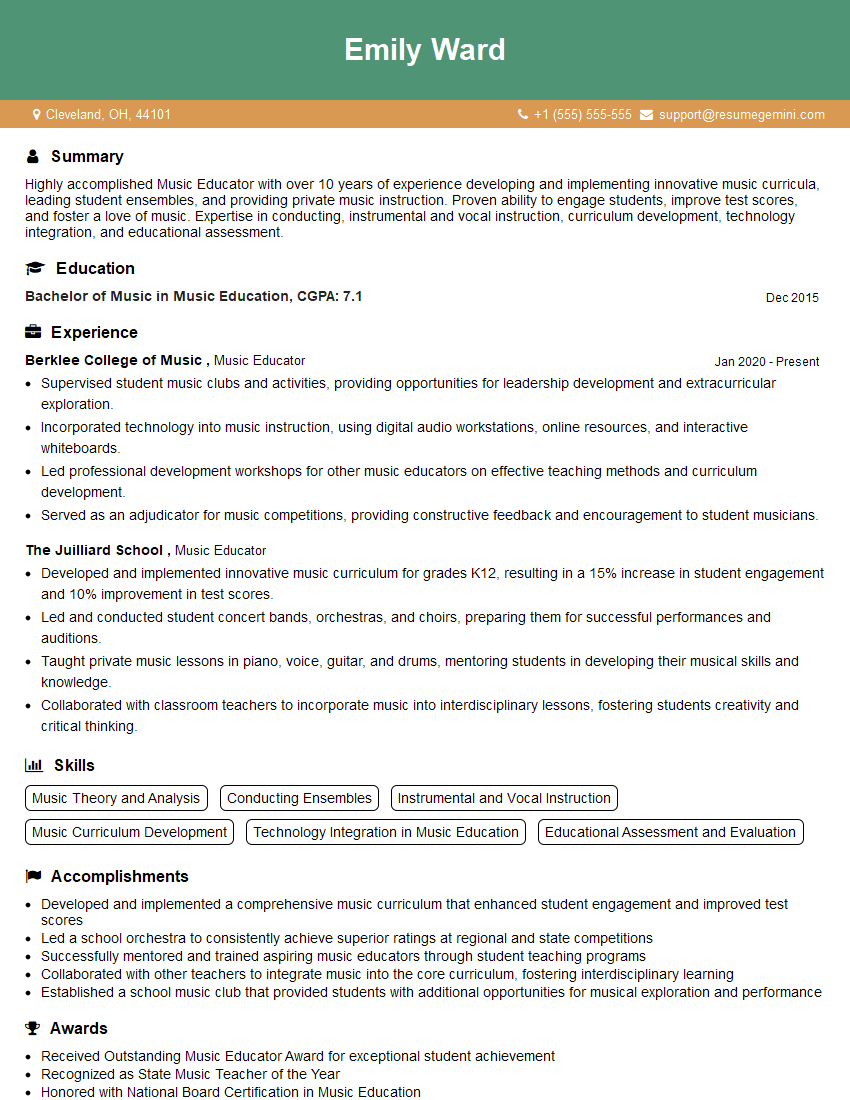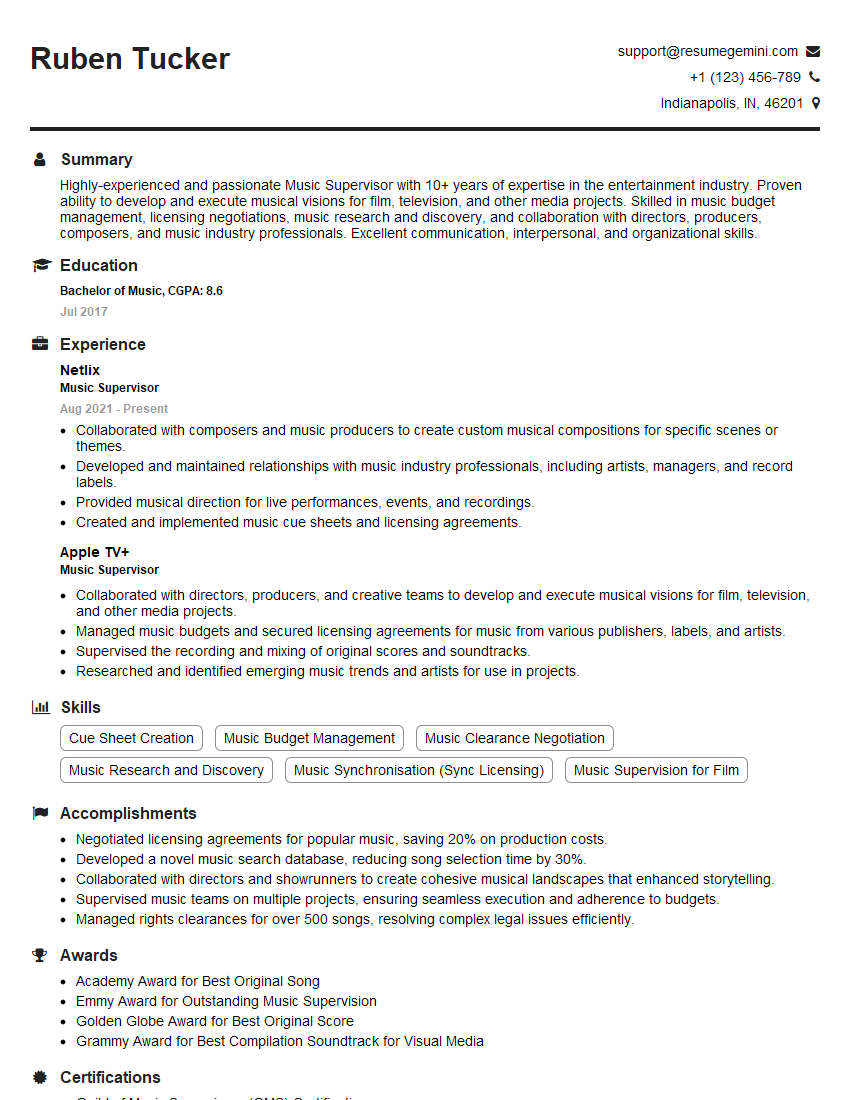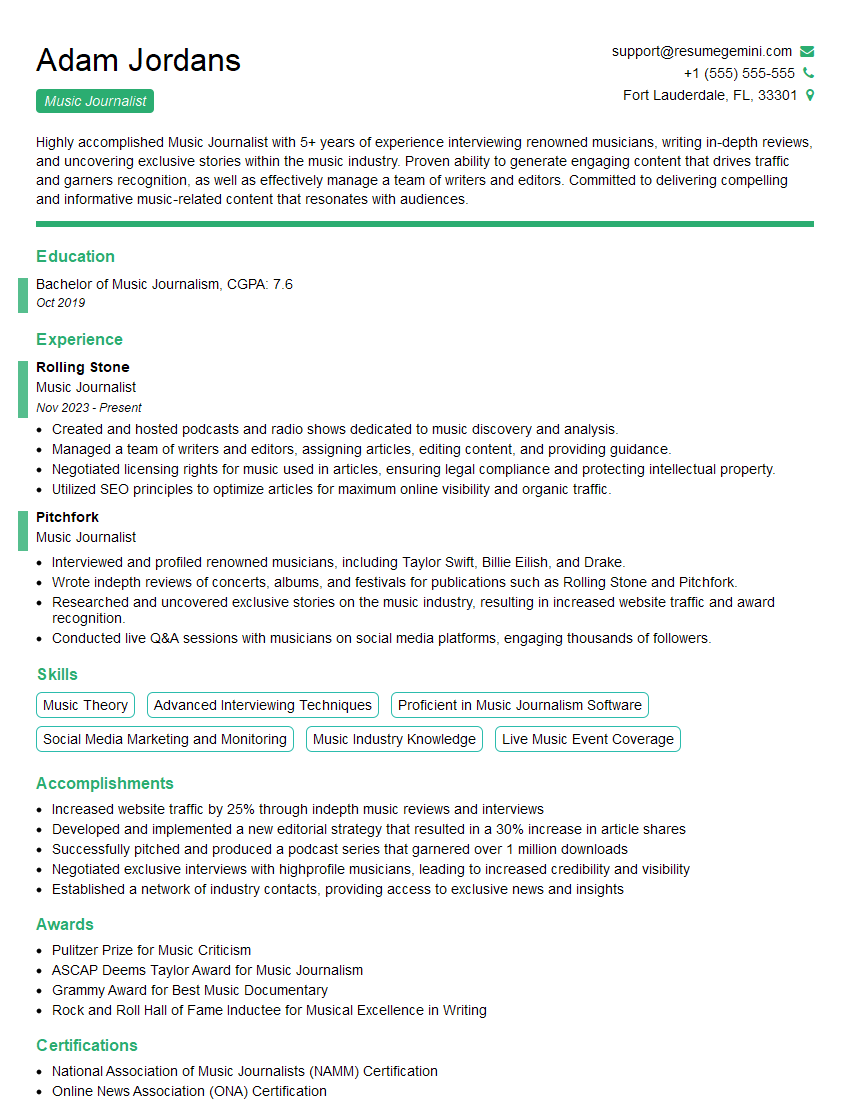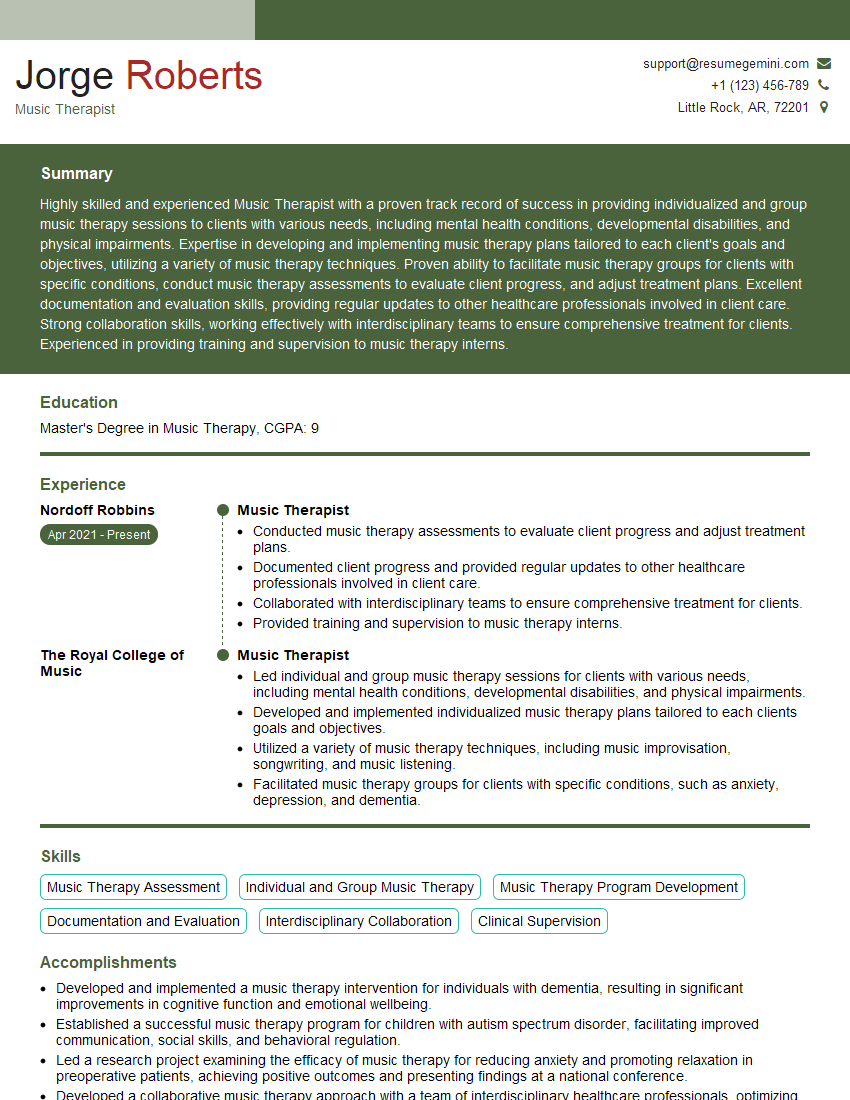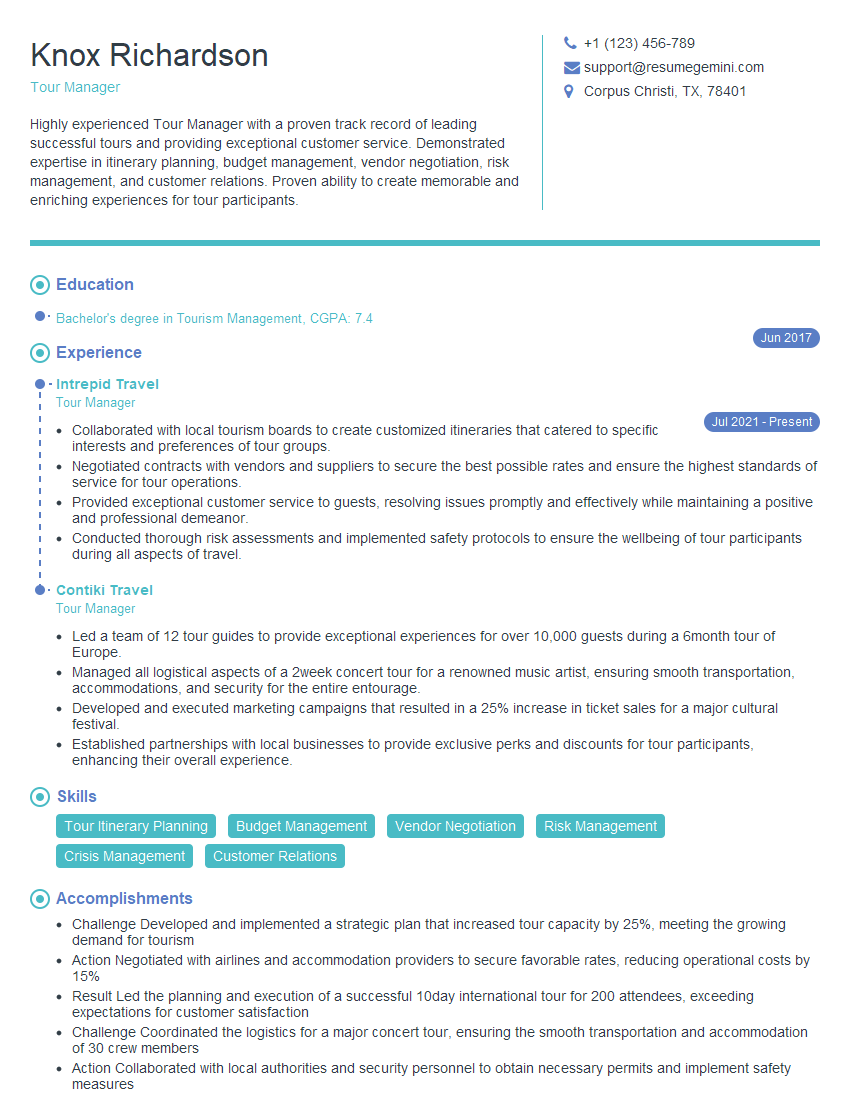Feeling uncertain about what to expect in your upcoming interview? We’ve got you covered! This blog highlights the most important Music Business and Industry Knowledge interview questions and provides actionable advice to help you stand out as the ideal candidate. Let’s pave the way for your success.
Questions Asked in Music Business and Industry Knowledge Interview
Q 1. Explain the current state of the music streaming market and its impact on artists’ revenue.
The music streaming market is currently dominated by a few major players, creating a complex landscape for artists. While streaming provides unprecedented access to a global audience, the revenue generated per stream is notoriously low. This translates to artists needing significantly higher streams to achieve a comparable income to previous models like physical album sales. The impact on artists’ revenue is multifaceted. They receive royalties based on a percentage of the subscription fees or ad revenue generated from their music streams. However, these percentages are often small, and the calculation methods can be opaque, leaving artists with limited control and transparency regarding their earnings. Furthermore, the rise of streaming has led to a decline in album sales, a previously significant revenue source for many artists.
For example, an artist might receive only a fraction of a cent per stream, meaning millions of streams are needed to generate a substantial income. This has led to increased reliance on touring, merchandise sales, and brand partnerships to supplement streaming income, highlighting the need for a more equitable and transparent streaming model.
Q 2. Describe the role of a music publisher and how they generate income for songwriters.
A music publisher acts as an intermediary between songwriters and music users. They acquire the copyright to songs, typically through a songwriter agreement, and then license those songs for various uses, generating income for the songwriters. Their key role is protecting and exploiting the songwriter’s intellectual property. A publisher’s income, and consequently the songwriter’s, comes from several sources:
- Mechanical Royalties: Paid when a song is reproduced, like on a physical album or a digital download.
- Performance Royalties: Earned when a song is played publicly, such as on the radio, in a club, or through a streaming service.
- Synchronization Licenses (Sync Licenses): Generated when a song is used in a film, TV show, advertisement, or video game. These are often high-value licenses.
- Print Royalties: Earned when sheet music or songbooks are sold.
In essence, the publisher acts as a marketing and licensing arm for the songwriter, handling the complex administrative and legal aspects involved in licensing their music.
Q 3. What are the key performance indicators (KPIs) you would track for a successful music marketing campaign?
Key Performance Indicators (KPIs) for a successful music marketing campaign depend on the campaign’s goals but usually include:
- Streams/Downloads: Measuring the number of streams across platforms like Spotify, Apple Music, etc., and digital downloads.
- Social Media Engagement: Tracking metrics such as likes, comments, shares, and follower growth across relevant platforms (e.g., Instagram, TikTok, YouTube).
- Website Traffic and Conversions: Monitoring website visits, email sign-ups, merchandise purchases, and ticket sales.
- Playlist Adds: Getting added to prominent playlists significantly boosts visibility and streams.
- Audience Growth: Tracking growth in fanbase size through various channels.
- Media Coverage: Monitoring reviews, press mentions, and radio play.
- Brand Partnerships: Measuring the effectiveness of collaborations in terms of reach and brand alignment.
- Return on Investment (ROI): Calculating the financial return compared to the marketing budget.
By tracking these KPIs, we gain insights into campaign effectiveness, identify areas for improvement, and demonstrate the campaign’s value.
Q 4. How do you identify and develop new talent in the music industry?
Identifying and developing new talent involves a multi-faceted approach. It’s less about a single magic formula and more about consistent scouting, nurturing, and strategic development. Here are key steps:
- Active Scouting: Attending live music events, reviewing submissions online, and collaborating with music schools and colleges.
- Networking: Building strong relationships with managers, agents, A&R representatives, and other industry professionals.
- Online Platforms: Utilizing platforms like SoundCloud, Bandcamp, and YouTube to discover emerging artists.
- A&R (Artists and Repertoire): A&R teams within record labels actively seek and sign new artists, playing a crucial role in artist development.
- Mentorship and Development: Once talent is identified, providing guidance on songwriting, performance, recording, marketing, and career management is crucial.
- Strategic Planning: Developing a long-term strategy for the artist’s career, including genre positioning, target audience, and marketing initiatives.
Essentially, it’s a combination of proactive search, strong networking, and a commitment to nurturing the artist’s growth.
Q 5. What are the different types of music licensing agreements, and when would you use each one?
Music licensing agreements vary depending on the intended use of the music. Here are a few key types:
- Mechanical License: Grants the right to reproduce and distribute a musical work. This is used for physical albums, digital downloads, and ringtones.
- Synchronization License (Sync License): Allows for the use of a musical composition in a visual medium such as film, television, advertisements, or video games. This often involves a significant fee.
- Performance License: Grants the right to publicly perform a musical work, often obtained through performing rights organizations (PROs) like ASCAP, BMI, or SESAC. This covers radio play, live performances, and streaming services.
- Print License: Grants the right to reproduce musical notation, such as sheet music.
- Master Use License: Grants the right to use the sound recording of a song (not just the composition). This is necessary for films, TV shows, commercials, and other uses requiring the actual recording.
The choice of license depends entirely on how the music will be used. For instance, a filmmaker would need a sync license and a master use license, whereas a radio station needs a performance license.
Q 6. Explain the process of securing a sync license for a song in a film or television show.
Securing a sync license is a multi-step process often involving intermediaries like music supervisors or music libraries. The process typically goes like this:
- Song Submission: Pitching songs to music supervisors (individuals who select music for film, television, advertising, etc.) or through music libraries.
- License Negotiation: If the song is selected, the publisher or songwriter will negotiate the license terms with the production company or licensor. This includes the fee, usage rights (geographic restrictions, duration, etc.), and credit to the songwriter.
- Contract Signing: A formal synchronization license agreement is drawn up and signed by all parties.
- Delivery of Materials: The necessary musical files are delivered to the production company in the required format.
- Payment and Reporting: Once the project is completed, payment is made to the publisher or songwriter, and usage reports are provided.
The negotiation stage is crucial as it determines the financial compensation and the scope of the license. It’s common to involve legal counsel to ensure favorable terms.
Q 7. How do you build and maintain relationships with key industry players?
Building and maintaining relationships in the music industry is paramount to success. It’s built on trust, mutual respect, and consistent communication. Key strategies include:
- Networking: Actively attending industry events, conferences, and showcases to meet and connect with people.
- Professional Communication: Maintaining consistent, respectful communication through email, phone calls, and in-person meetings.
- Value Creation: Offering value to others by sharing information, providing assistance, and demonstrating professionalism.
- Relationship Building: Nurturing relationships through regular check-ins, invitations to events, and offers of support.
- Follow Through: Being reliable and fulfilling commitments to maintain credibility and trust.
- Mutual Benefit: Focusing on mutually beneficial relationships rather than solely self-serving interactions.
Building strong industry relationships is an ongoing process requiring genuine effort and a long-term perspective. It’s essential for both finding opportunities and navigating the challenges of this dynamic field. Think of it as cultivating a garden: consistent effort yields strong and lasting results.
Q 8. Describe your experience with music budgeting and financial forecasting.
Music budgeting and financial forecasting are crucial for the success of any musical project, from a small independent artist to a major label release. It involves meticulously planning and tracking income and expenses to ensure financial stability and profitability. This goes beyond simply creating a budget; it involves understanding the revenue streams, anticipating potential costs, and proactively adjusting strategies based on performance.
My experience encompasses creating comprehensive budgets that include recording costs (studio time, engineers, musicians), production costs (mixing, mastering, artwork), marketing and promotion (social media campaigns, PR, advertising), distribution fees (digital platforms, physical manufacturing), touring expenses (travel, accommodation, venue fees, crew), and artist royalties/payments. I utilize spreadsheet software like Excel or specialized music industry software to create detailed line items and track spending against the budget. I regularly perform variance analysis, comparing actual spending to projected costs, identifying areas of overspending or underspending, and adjusting the forecast accordingly. For example, if a social media campaign is exceeding its budget yet demonstrating a significant return on investment, I’d advocate for increasing the allocated funds. Conversely, if a less effective marketing strategy is over budget, I would recommend reallocating resources.
Financial forecasting extends beyond the immediate project. I build long-term financial models to project revenue based on sales projections (streaming, downloads, physical sales, merchandise), licensing deals, touring income, and sponsorship opportunities. These models are dynamic, allowing for adjustments based on market trends and performance data. This forecasting process informs strategic decision-making, guiding investment decisions and resource allocation. For instance, if the forecast suggests strong potential for touring, we might invest more in building a tour infrastructure earlier in the project timeline.
Q 9. What are some current trends in the music industry that excite you?
The music industry is in a constant state of evolution, and several current trends are incredibly exciting. One is the rise of AI-powered music creation tools. While some fear job displacement, I see this as a democratizing force, providing artists with affordable and accessible tools to create and produce music. It can augment creativity, not replace it. Another trend I find fascinating is the growing importance of immersive experiences. The metaverse, virtual concerts, and interactive audio-visual shows are pushing the boundaries of how artists connect with their audience, creating new and engaging revenue streams.
Finally, the continued growth and diversification of global music markets is a positive development. Artists from around the world are gaining global recognition, and we’re seeing a richer, more diverse range of musical styles and influences. This expansion necessitates a deeper understanding of regional nuances in marketing and promotion. For example, a campaign targeting Latin America will differ significantly from one targeting East Asia, requiring localized strategies and culturally sensitive approaches.
Q 10. How do you navigate copyright issues and royalty payments?
Navigating copyright and royalty payments is a critical aspect of the music business, requiring careful attention to detail and a proactive approach. My approach begins with understanding the different types of copyright (mechanical, performance, synchronization, etc.) and ensuring that all necessary clearances are obtained before any use of copyrighted material. This involves working closely with music publishers, PROs (Performing Rights Organizations like ASCAP, BMI, SESAC), and copyright lawyers to secure appropriate licenses and agreements.
For royalty payments, I ensure that accurate tracking systems are in place. This involves registering works with the relevant PROs, maintaining detailed records of usage, and working with digital distribution platforms to accurately track streams and downloads. Understanding the different royalty structures (e.g., mechanical royalties, performance royalties, streaming royalties) and the applicable rates is essential. Regular reconciliation with distributors and PROs is crucial to identify discrepancies and ensure timely and accurate payment. I’ve encountered instances where incorrect metadata resulted in misallocation of royalties, highlighting the critical need for detailed record-keeping and rigorous verification. Proactive communication with all stakeholders involved is paramount for resolving any disputes efficiently and ensuring transparency.
Q 11. How familiar are you with digital distribution platforms and their functions?
I have extensive familiarity with digital distribution platforms and their functions. These platforms, such as DistroKid, TuneCore, CD Baby, and others, are essential for getting music to listeners. My understanding goes beyond simply uploading files; I’m proficient in managing metadata (song titles, artist names, album art, ISRC codes, UPC codes), which is critical for efficient searching and royalty tracking. I understand how different platforms’ algorithms work, influencing search ranking and visibility. Furthermore, I understand the various distribution options available, from single-track releases to album releases, and the impact of these choices on artist strategies.
I can analyze platform analytics to understand an artist’s performance, identifying trends and informing future promotional strategies. For example, if analytics reveal a particular song consistently outperforms others on a specific platform, we can tailor marketing efforts to maximize its reach. I also understand the nuances of different platform agreements and associated fees, negotiating favorable terms where possible and choosing platforms that best align with the artist’s goals and target audience.
Q 12. What are some effective strategies for promoting an artist on social media?
Effective social media promotion for artists requires a multi-faceted approach combining organic engagement and paid advertising. It’s not enough to simply post; it’s about building a community and creating meaningful interactions. I develop tailored strategies based on the artist’s brand, genre, and target audience, using a blend of platforms like Instagram, TikTok, Facebook, and YouTube. This includes consistent posting of high-quality content (music snippets, behind-the-scenes footage, engaging visuals), strategic use of hashtags, and participation in relevant online communities.
Paid advertising campaigns on platforms like Facebook and Instagram are leveraged to reach a broader audience, targeting specific demographics based on interests and listening habits. Analyzing campaign performance data is critical for optimizing ad spend and maximizing return on investment. Building a strong email list is also crucial for direct communication with fans, announcing new releases, tour dates, and exclusive content. Interacting with comments, responding to messages, and actively engaging with fans build a loyal following. A successful strategy goes beyond simply promoting music; it builds relationships and cultivates a sense of community.
Q 13. Explain the difference between a record label and a music distributor.
While both record labels and music distributors play a vital role in getting music to market, they have distinct functions. A record label is a much broader entity, typically acting as a comprehensive partner to artists. They handle artist development, A&R (Artists and Repertoire), marketing and promotion, publishing, distribution (sometimes), and financing. Labels invest significantly in their artists, providing resources and expertise to build their careers. They often sign artists to exclusive contracts, managing their creative output and commercial exploitation.
A music distributor, on the other hand, focuses solely on the distribution aspect. They handle the technical process of getting music onto digital platforms (like Spotify, Apple Music, etc.) and physical stores. They receive the finished recordings from artists or labels and handle the technical aspects of uploading, metadata management, and collecting royalties. Distributors are essentially the delivery service, not the creative partner. They often work with independent artists and smaller labels that lack the internal resources to handle distribution themselves. Artists may choose to work directly with distributors without the involvement of a record label.
Q 14. How do you handle artist disputes or conflicts?
Artist disputes can range from creative differences to financial disagreements. My approach emphasizes proactive communication and conflict resolution. Early and open communication is key, addressing potential issues before they escalate. I facilitate collaborative discussions, ensuring all parties have a voice and feel heard. This may involve mediating disagreements about creative direction, marketing strategies, or financial allocations. When necessary, I bring in legal counsel to ensure all parties’ rights are protected and contracts are upheld.
A structured approach is crucial. I clearly define roles and responsibilities from the outset, ensuring transparency in financial dealings and decision-making processes. I use clear, concise communication, documenting agreements and decisions to minimize ambiguity and avoid future conflicts. When irreconcilable differences arise, a structured separation process is implemented, ensuring fair treatment and a smooth transition for all parties involved. Mediation and negotiation are preferred to litigation, as they preserve relationships and minimize disruption to the project’s progress.
Q 15. Describe your experience with music contract negotiation.
Music contract negotiation is a delicate dance requiring a deep understanding of music law, business acumen, and the specific needs of both the artist and the label (or other party). It’s not simply about haggling over percentages; it’s about crafting a legally sound and mutually beneficial agreement that protects everyone involved.
My experience spans diverse contract types, including recording agreements, publishing deals, and artist management contracts. I’ve successfully negotiated favorable terms for artists ranging from unsigned newcomers to established acts. This includes defining royalty structures, deliverables, advance payments, term lengths, and intellectual property rights. I leverage a thorough understanding of industry standards and best practices, while also tailoring each contract to the unique circumstances of the artist and their career trajectory. A critical component is pre-negotiation due diligence – thoroughly understanding the artist’s market value and potential before entering discussions.
For instance, I recently negotiated a recording agreement for a promising indie artist where we secured a higher-than-average royalty rate due to strong streaming projections and pre-existing fan base. This required detailed financial modeling and leveraging market data to demonstrate the artist’s unique value proposition. Another key aspect is understanding the nuances of different contract clauses, particularly concerning ownership, exploitation rights, and termination clauses. A poorly worded clause can have significant financial and legal repercussions down the line.
Career Expert Tips:
- Ace those interviews! Prepare effectively by reviewing the Top 50 Most Common Interview Questions on ResumeGemini.
- Navigate your job search with confidence! Explore a wide range of Career Tips on ResumeGemini. Learn about common challenges and recommendations to overcome them.
- Craft the perfect resume! Master the Art of Resume Writing with ResumeGemini’s guide. Showcase your unique qualifications and achievements effectively.
- Don’t miss out on holiday savings! Build your dream resume with ResumeGemini’s ATS optimized templates.
Q 16. What are some effective ways to track the performance of a music release?
Tracking the performance of a music release requires a multifaceted approach combining quantitative data with qualitative analysis. We must move beyond simple sales figures to understand the full impact of the release across various platforms.
- Streaming Platforms (Spotify, Apple Music, etc.): Regularly monitor streams, listeners, playlist adds, and engagement metrics. Platforms provide detailed dashboards showing geographic distribution, demographics, and listener behavior.
- Digital Downloads & Sales: Track sales on platforms like iTunes, Bandcamp, and Amazon Music. Analyze sales data for trends, identifying peak sales periods and regions of strong performance.
- Social Media Engagement: Measure the impact of social media campaigns by tracking mentions, shares, likes, and comments on platforms like Instagram, TikTok, and Facebook. This provides insights into audience sentiment and brand awareness.
- Radio Airplay: Monitor radio play via monitoring services. Radio remains a powerful promotional tool, particularly for certain genres.
- YouTube & Video Platforms: Track views, likes, comments, and shares of official music videos and lyric videos. This provides insights into visual engagement and audience interest.
By combining data from these various sources, a comprehensive picture of the release’s performance emerges. This allows for informed decision-making concerning future marketing strategies, artist development, and potential re-releases or remixes.
Q 17. How familiar are you with various music analytics platforms and data interpretation?
I’m highly familiar with various music analytics platforms and proficient in interpreting the data they provide. My experience encompasses platforms such as Spotify for Artists, Apple Music for Artists, YouTube Analytics, Soundcloud Pro, and third-party analytics tools like Chartmetric and Music Gateway.
Data interpretation is key. It’s not enough to simply look at raw numbers. I focus on understanding trends, identifying anomalies, and drawing meaningful conclusions. For example, a sudden spike in streams from a particular region could indicate a successful local marketing campaign or a viral trend. Conversely, a drop in engagement may signal the need for a revised marketing strategy or a change in audience preferences. I use this data to inform A/B testing of marketing campaigns, predict future performance, and optimize resource allocation.
Understanding the limitations of data is also crucial. While analytics provide valuable insights, they don’t tell the whole story. It’s important to consider contextual factors such as seasonality, marketing efforts, and the overall competitive landscape.
Q 18. Discuss your experience with music marketing analytics and ROI calculations.
Music marketing analytics and ROI calculations are essential for demonstrating the effectiveness of marketing campaigns and justifying investment. My experience in this area allows me to design, implement, and measure marketing strategies, providing detailed ROI reports to stakeholders.
I typically utilize a combination of methods: first, setting clear, measurable goals for each campaign. These goals could include increasing streams, boosting social media engagement, or driving ticket sales. Next, I establish key performance indicators (KPIs) to track progress towards these goals. These KPIs might include cost per stream, return on ad spend (ROAS), click-through rates, and conversion rates.
After a campaign concludes, I perform a comprehensive analysis of the data, comparing the actual results against the established KPIs. This analysis enables accurate ROI calculations, determining the overall effectiveness of the marketing spend. For example, a successful campaign might show a ROAS of 3:1, indicating that every dollar spent generated three dollars in revenue. A detailed breakdown of the campaign’s performance, including channel-specific ROI, is crucial for making data-driven decisions for future campaigns.
Q 19. How would you measure the success of a live music event?
Measuring the success of a live music event goes beyond simply counting ticket sales. It requires a holistic approach considering various factors that contribute to the overall experience and its impact.
- Ticket Sales & Attendance: This is the most basic metric, reflecting the event’s popularity and reach. However, it’s crucial to compare attendance against the venue’s capacity to gauge how well the event sold out.
- Audience Engagement: Observing audience reactions during the performance (energy levels, singing along, dancing) provides qualitative insights into the show’s impact.
- Social Media Buzz: Monitoring social media chatter surrounding the event offers insights into audience sentiment and the event’s overall reception. The number of posts, mentions, and hashtags can reflect the buzz surrounding the event.
- Merchandise Sales: Strong merchandise sales indicate audience engagement and willingness to support the artist beyond the ticket purchase.
- Post-Event Surveys: Gathering feedback from attendees provides valuable qualitative insights into audience satisfaction and identifies areas for improvement in future events.
- Financial Performance: Analyzing the event’s overall financial performance, including expenses (venue rental, marketing, artist fees) and revenue (ticket sales, merchandise, concessions), is vital for assessing profitability and return on investment.
A successful live music event combines strong attendance with high audience satisfaction, leading to positive word-of-mouth and repeat business.
Q 20. Describe your understanding of different music genres and their target audiences.
My understanding of music genres and their target audiences is extensive. I recognize that each genre possesses unique characteristics that resonate with specific demographics and psychographics. This understanding is crucial for effective marketing and artist development.
For example, the target audience for a mainstream pop artist will differ significantly from that of an underground metal band. Pop music typically targets a broader, younger demographic interested in catchy melodies and relatable lyrics. Conversely, metal music often resonates with a more niche audience who value complex musical structures and aggressive energy. Understanding these nuances allows for targeted marketing efforts; a pop artist’s promotional campaign would differ drastically from that of a metal band.
Furthermore, generational shifts and evolving cultural trends significantly influence audience preferences. Knowing how these shifts impact different genres is crucial for predicting market trends and identifying opportunities. For instance, the rise of TikTok has drastically impacted the popularity of certain genres, creating new avenues for discovery and marketing.
Q 21. How do you identify potential risks and opportunities in the music business?
Identifying potential risks and opportunities in the music business requires a keen eye for emerging trends, a strong understanding of the industry landscape, and the ability to analyze market data.
Potential Risks:
- Copyright Infringement: The ease of digital distribution increases the risk of unauthorized reproduction and distribution of music.
- Changing Technology & Distribution Models: The ever-evolving digital landscape creates uncertainty regarding revenue streams and audience engagement.
- Market Saturation: The abundance of artists competing for attention increases the difficulty of breaking through the noise.
- Economic Downturns: Economic recessions can significantly impact consumer spending, affecting ticket sales and merchandise revenues.
- Legal Issues: Contracts, intellectual property rights, and licensing agreements require careful attention to avoid legal problems.
Potential Opportunities:
- New Technologies: Emerging technologies like AI and virtual reality create new opportunities for content creation, artist promotion, and fan engagement.
- Niche Markets: Focusing on niche genres or subcultures can provide a distinct advantage by catering to a loyal, engaged fan base.
- Global Reach of Digital Platforms: Digital distribution enables artists to reach global audiences, significantly expanding their market potential.
- Strategic Partnerships: Collaborations with brands, influencers, and other artists can enhance visibility and broaden reach.
- Diversification of Revenue Streams: Exploring various income streams such as merchandise, live performances, licensing, and endorsements helps reduce reliance on a single income source.
By proactively identifying and mitigating risks, while strategically seizing opportunities, one can navigate the ever-changing music industry landscape more effectively.
Q 22. What is your experience with music industry software and tools?
My experience with music industry software and tools spans a wide range, encompassing everything from Digital Audio Workstations (DAWs) like Pro Tools and Logic Pro X for recording and production, to music distribution platforms such as DistroKid and TuneCore, and marketing and analytics tools like Spotify for Artists and YouTube Analytics. I’m also proficient in project management software like Asana and Trello for organizing campaigns and artist collaborations. Beyond these, I have experience using social media management tools like Buffer and Hootsuite for targeted marketing efforts. My proficiency extends to accounting software specific to the music business, enabling me to manage artist royalties and budgets effectively. I understand the importance of leveraging technology to optimize workflows and maximize impact across the entire music lifecycle.
For example, I once used a combination of Pro Tools, Logic Pro X, and iZotope Ozone to master a track for an independent artist, significantly improving its sound quality and marketability. This involved careful mastering techniques combined with detailed analysis using iZotope’s tools to ensure optimal loudness and clarity.
Q 23. How do you stay current with the evolving landscape of the music industry?
Staying current in the ever-evolving music industry demands a multifaceted approach. I regularly subscribe to and read industry publications such as Billboard, Variety, and Music Business Worldwide. I actively participate in industry conferences and webinars, networking with professionals and learning about the latest trends and technologies. I follow key players on social media, including artists, labels, and industry analysts, to keep my finger on the pulse of emerging trends. Furthermore, I analyze market data from streaming platforms and other sources to understand audience behavior and preferences, which influences my strategic decision-making. Continuous learning is essential, and I dedicate time to studying new technologies and marketing strategies to maintain a competitive edge.
For instance, the rise of AI in music production is a significant development. I’ve been proactively exploring AI tools to assess their potential applications in music creation and marketing, always looking for ways to leverage technology to add value for artists.
Q 24. Explain your understanding of the different revenue streams for artists.
Artists today have a diverse range of revenue streams, extending far beyond traditional album sales. These include:
- Streaming Royalties: Income generated from platforms like Spotify, Apple Music, and Amazon Music. This is currently a major revenue source for many artists.
- Physical Sales: Revenue from CD, vinyl, and cassette sales, which still holds significance for some genres and artists.
- Digital Downloads: Sales of individual tracks or albums from platforms like iTunes and Bandcamp.
- Publishing Royalties: Income earned from the performance and reproduction of their compositions (if they own their publishing rights).
- Synchronization Licensing (Sync): Licensing music for use in films, television shows, advertisements, and video games.
- Merchandising: Sales of branded merchandise, such as t-shirts, posters, and other fan-related items.
- Live Performances: Income from concerts, tours, and other live events. This is often a significant revenue stream for many artists.
- Brand Partnerships and Sponsorships: Collaborations with brands for endorsements, product placement, and other promotional activities.
- Crowdfunding: Raising funds from fans through platforms like Kickstarter and Patreon.
It’s crucial for artists to diversify their revenue streams to create a stable and sustainable income, mitigating reliance on any single source.
Q 25. Discuss your experience with creating and implementing marketing plans for musical artists.
My experience in creating and implementing marketing plans for musical artists involves a comprehensive, data-driven approach. I begin by thoroughly understanding the artist’s brand, target audience, and musical style. This informs the creation of a tailored marketing strategy encompassing several key areas:
- Target Audience Identification: Defining the ideal listener profile, including demographics, listening habits, and online behavior.
- Social Media Strategy: Developing a content calendar featuring engaging posts, stories, and videos tailored to each platform. This also includes targeted advertising campaigns.
- Public Relations: Securing media coverage through press releases, interviews, and influencer outreach.
- Email Marketing: Building an email list and sending targeted email campaigns to keep fans engaged and informed.
- Website and Online Presence: Ensuring a professional and user-friendly website with up-to-date information and high-quality media.
- Playlist Placement: Strategically submitting music to relevant playlists on streaming services.
- Performance Marketing: Utilizing paid advertising to reach wider audiences on platforms like Facebook, Instagram, and YouTube.
- Data Analytics: Closely tracking campaign performance using analytics tools to optimize and improve results.
For example, I recently helped a singer-songwriter launch their new album by focusing on a hyper-targeted Instagram campaign featuring short videos showcasing their musical style, coupled with a strategic playlist pitch to major streaming services. This resulted in a significant increase in both streaming numbers and new followers.
Q 26. What are some ethical considerations in the music business?
Ethical considerations in the music business are paramount. Key areas of concern include:
- Fair Compensation and Royalties: Ensuring artists receive fair compensation for their work, including transparent and accurate royalty payments from streaming services and other sources. This also involves fair contracts and avoiding exploitative agreements.
- Copyright Infringement: Protecting artists’ intellectual property rights from unauthorized use or distribution.
- Transparency and Honesty: Maintaining transparency in dealings with artists, labels, publishers, and other stakeholders.
- Data Privacy: Protecting the privacy of artist and fan data, complying with data protection regulations like GDPR.
- Cultural Sensitivity: Avoiding appropriation or misrepresentation of cultural elements in music and marketing materials.
- Environmental Impact: Considering the environmental impact of music production, distribution, and consumption, promoting sustainable practices.
Ethical behavior builds trust and fosters long-term success in the industry. A strong ethical foundation is crucial for maintaining integrity and positive relationships with all stakeholders.
Q 27. How do you build and maintain artist relationships?
Building and maintaining strong artist relationships is foundational to success in the music business. This involves:
- Open Communication: Maintaining consistent and transparent communication with artists, actively listening to their concerns and providing regular updates.
- Mutual Respect: Treating artists with respect and valuing their creative vision.
- Shared Goals: Working collaboratively towards shared goals, aligning interests and creating a win-win situation.
- Trust and Reliability: Being reliable and dependable, consistently meeting commitments and delivering on promises.
- Regular Check-Ins: Scheduling regular meetings or calls to discuss progress, challenges, and future plans.
- Feedback and Support: Providing constructive feedback and offering support during challenging periods.
- Celebrating Successes: Celebrating milestones and achievements to foster a positive and collaborative environment.
I believe that building a relationship based on trust and mutual respect is far more valuable than a transactional approach. A strong relationship leads to more creative freedom, better collaboration, and ultimate success for the artist.
Q 28. How would you approach crisis management in a music-related situation?
Crisis management in the music industry demands a swift, decisive, and transparent approach. My strategy would involve:
- Rapid Assessment: Quickly assess the situation, identifying the severity, scope, and potential impact.
- Team Mobilization: Assemble a crisis management team, including relevant stakeholders, such as legal counsel, publicists, and the artist’s management.
- Communication Strategy: Develop a clear and consistent communication plan, addressing the situation promptly and honestly with all stakeholders.
- Damage Control: Implement measures to mitigate the negative impact, such as issuing public statements, addressing misinformation, and proactively managing online narratives.
- Problem Solving: Identify and implement solutions to address the root cause of the crisis.
- Monitoring and Evaluation: Continuously monitor the situation and evaluate the effectiveness of the crisis management strategy. Adapt the approach as needed.
- Post-Crisis Review: Conduct a thorough review of the crisis, identifying lessons learned and implementing measures to prevent similar situations in the future.
For instance, if an artist were involved in a public controversy, a rapid response involving a well-crafted public statement addressing the issue directly and transparently, alongside proactively managing online comments, could help mitigate negative publicity.
Key Topics to Learn for Music Business and Industry Knowledge Interview
- Copyright and Royalties: Understanding the complexities of music licensing, copyright law, and royalty distribution models (mechanical, performance, digital). Practical application: Analyzing a royalty statement and identifying potential discrepancies.
- Record Labels and A&R: The role of record labels in artist development, marketing, and distribution. Practical application: Evaluating the strengths and weaknesses of different label models and their impact on artist careers.
- Music Publishing: The process of music publishing, including copyright administration, synchronization licensing, and revenue streams. Practical application: Negotiating a publishing deal and understanding the implications of different contract terms.
- Digital Music Distribution and Streaming: Understanding the major streaming platforms, their algorithms, and their impact on artist revenue. Practical application: Developing a digital marketing strategy for an artist leveraging various streaming platforms.
- Artist Management: The responsibilities of an artist manager, including career planning, contract negotiation, and financial management. Practical application: Creating a strategic plan for an artist’s career growth and sustainability.
- Music Marketing and Promotion: Strategies for effective music marketing and promotion, including social media marketing, public relations, and advertising. Practical application: Developing a marketing campaign for a new artist release.
- Live Music Venues and Events: Understanding the business model of live music venues, event production, and concert promotion. Practical application: Creating a budget and logistical plan for a small music festival.
- Music Business Finance and Accounting: Fundamental accounting principles relevant to the music industry, including budgeting, forecasting, and financial statement analysis. Practical application: Creating a realistic budget for an independent artist’s release.
- Legal Aspects of the Music Industry: Understanding key legal concepts such as contracts, intellectual property, and artist agreements. Practical application: Reviewing and understanding the implications of a standard artist management agreement.
Next Steps
Mastering Music Business and Industry Knowledge is crucial for career advancement. A strong understanding of these concepts demonstrates your preparedness and passion, significantly increasing your interview success rate. To further enhance your job prospects, create an ATS-friendly resume that highlights your skills and experience effectively. ResumeGemini is a trusted resource that can help you build a professional and impactful resume. Examples of resumes tailored specifically to Music Business and Industry Knowledge are available to guide you. Take the next step toward your dream career in the music industry today!
Explore more articles
Users Rating of Our Blogs
Share Your Experience
We value your feedback! Please rate our content and share your thoughts (optional).
What Readers Say About Our Blog
Hello,
We found issues with your domain’s email setup that may be sending your messages to spam or blocking them completely. InboxShield Mini shows you how to fix it in minutes — no tech skills required.
Scan your domain now for details: https://inboxshield-mini.com/
— Adam @ InboxShield Mini
Reply STOP to unsubscribe
Hi, are you owner of interviewgemini.com? What if I told you I could help you find extra time in your schedule, reconnect with leads you didn’t even realize you missed, and bring in more “I want to work with you” conversations, without increasing your ad spend or hiring a full-time employee?
All with a flexible, budget-friendly service that could easily pay for itself. Sounds good?
Would it be nice to jump on a quick 10-minute call so I can show you exactly how we make this work?
Best,
Hapei
Marketing Director
Hey, I know you’re the owner of interviewgemini.com. I’ll be quick.
Fundraising for your business is tough and time-consuming. We make it easier by guaranteeing two private investor meetings each month, for six months. No demos, no pitch events – just direct introductions to active investors matched to your startup.
If youR17;re raising, this could help you build real momentum. Want me to send more info?
Hi, I represent an SEO company that specialises in getting you AI citations and higher rankings on Google. I’d like to offer you a 100% free SEO audit for your website. Would you be interested?
Hi, I represent an SEO company that specialises in getting you AI citations and higher rankings on Google. I’d like to offer you a 100% free SEO audit for your website. Would you be interested?
good
